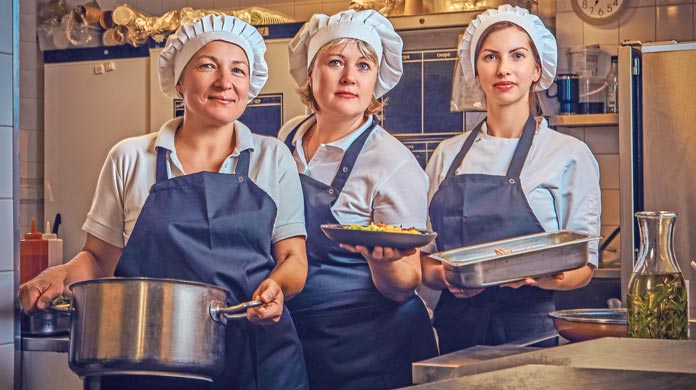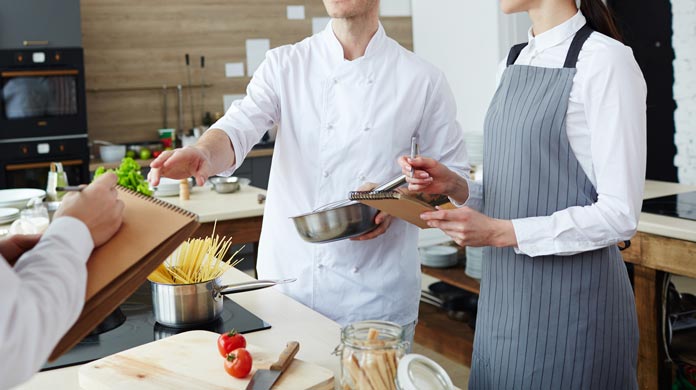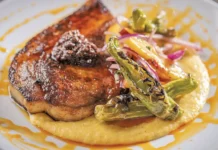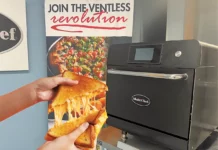
After 4 months on the sidelines, Metro New York City’s restaurants are in the process of reopening with outdoor dining and welcoming back dining patrons to their indoor dining rooms. As we seek to protect our waitstaff, culinary teams and, of course, our patrons, there are new clean and safety protocols that are being put in place.
At the top of that list are the items that can theoretically spread the virus. Hard surfaces, like a tabletop, are certainly a concern, but what about fabrics like clothing, tableclothes and napkins? As we did our homework, we found that a return to good old days of a clean tablecloth may hold the key to a virus free/safe reopening.

So Total Food Service sought out one of the foremost experts on the subject: Mark Lewis, Corporate Sales manager of Dempsey Uniform & Linen to get his thoughts and help our readers create a strategy for their linens and uniforms as the industry returns.
Have you been working from home?
No I have been working in the office. The Department of Homeland Security included our industry as one which supports crucial supply chains, like grocery stores. It’s been interesting because, I was actually in charge of the COVID response for the company.
What internal changes did you make to protect your team and the plant from the virus?
We divided the company into red and blue teams, and employee pods. We worked from home on the off days and rotated people through the laundry. We also installed partitions so that as we bring employees back, we can still keep people separated and following very stringent sanitation rules in the plant. We had a couple of people that were laid off test positive, while off but it never got into our plant.
Dempsey has been involved with your industry’s trade association, the TRSA for many years. What can we take for their new suggested protocols?
The TRSA really has three main roles not necessarily in order, but one is to advocate for our industry from a lobbying standpoint in Washington so that our industry has a single voice. Secondly, they serve as the accrediting agency for our hygienically clean and clean green industry certification standards. Third, they educate the industry in best practices.
Will green be replaced by a focus on safety?
It’s really about them co-existing to create more value for our customers. Clean Green Certification has really driven companies to be more environmentally friendly, which results in both resource conservation and lower operating costs. In addition, it pushes laundry technologies to improve and maximize cleanliness while reducing water and energy use. With TRSA’s lead, there are now over a hundred plants across the country that are Clean Green certified, which means that they had to meet high sustainability standards.. It’s a competitive difference so that a restaurant will choose to do business with us because we are more environmentally committed than the next. Now with Covid-19, focus has moved to Hygienically Clean Certification, which reflects a laundry’s commitment to producing hygienically clean textiles. Best management practices are verified by an on-site inspection and textiles are sent for biological texting each quarter.
How has the pandemic changed what your customers are asking for?
Right out of the gate, customers wanted us to provide tracking of their items through the entire cleaning process. Our TRSA Hygienically Clean Certification enabled us to clear those obstacles quickly because our cleaning processes are documented and our products are tested. It’s interesting, we know when restaurants reopen, we will be busy with that core work but in the interim, there is huge demand from dentists who now are required to wear fluid resistant gowns and professionally laundered scrubs.
 As guests start to come back to restaurants, do clean white linens and uniforms send the right message to a returning customer?
As guests start to come back to restaurants, do clean white linens and uniforms send the right message to a returning customer?
Again, I’m going to defer to the TRSA research that asks the question, “Can you/do you want to depend on an employee with a spray bottle to properly clean and sanitize a tabletop after every guest?” We haven’t even discussed what happens to the quality and consistency of that table cleaning process as restaurants get busy? There’s been plenty of studies done where people have gone into restaurants and tested tabletops to have them come back with all kinds of nasty bacteria. Clearly, the utilization of a clean tablecloth instantly provides a clean, hygienic surface to dine on. That sends the right message and makes customers feel comfortable and safe.
Many in our industry are looking for outdoor dining to provide an economic lifeline. What are your suggestions for the use of linen outdoors?
Our tablecloth demand has increased due to outdoor dining. Restaurateurs want to bring the best of their restaurant outside with them, from fine food, to exceptional service to an upscale atmosphere. A tablecloth elevates the experience of outdoor dining and makes any table look good. Plus, it creates a clean, sanitary surface where guests aren’t afraid to place their flatware. Some more casual outdoor dining establishments have chosen napkins and placemats. In some cases, we see a hybrid approach with the right napkin, like a bistro-napkin, used as a placemat. In addition we see increased demand for uniforms that can be laundered professionally at the end of each shift , hand sanitizer stations in multiple locations, and a real clean restroom that’s stocked properly.
What staff training do you suggest for making the most of an investment in clean linen?
The first thing is the tablecloths need to be changed after every table turn. There’s an age old way to cheat and that’s to flip and reuse a tablecloth. You just can’t do that in the age of Covid-19. If you use it more than once, there’s, data that shows the bacteria builds up. The right way is to make sure the laundered linens are sealed, stored in plastic and kept in a clean, dry place. When staff lays a tablecloth on a table, they should hold it by the edges the edges.
What about professional laundering versus home washing with uniforms?
The first consideration is what employees might bring from home on their clothes into your workplace. Having a hygienically clean uniform waiting for them at work is the best solution. The second consideration is how employees might be washing their uniforms at home. As a Certified Hygienically Clean laundry, we go through a whole lot of effort to make sure that all of the uniforms are washed at the proper temperatures and with the proper chemicals. Killing all of the bacteria and viruses requires a wash temperature of 150 degrees which you simply can’t accomplish in a home machine. The third consideration is how green you want to be, because it takes five gallons of water per pound of laundry in a home machine, and our million dollar washer and high-tech chemistry can do it in less than one.
What are your suggestions for best practices for managing a uniform program in a restaurant?
The first is to choose a uniform rental supplier that tracks the uniforms with RFID chips. You’ll looks track of the uniforms and their cost if you can’t track them to and from the laundry. The best uniform delivery system includes independent lockers, which our industry provides in a fairly small footprint. Each person can have their own locker for clean uniforms and then all soiled uniforms goes into a lockup bin., When employees arrive at work, they change into their clean uniforms. At the end of their shift, they leave the soiled uniforms in a bin. In today’s environment, here should be a hand sanitizer station right next to the bin.
Do you suggest a washable or a disposable mask program for a restaurant?
We’ve dug into the whole facemask requirement pretty heavily. We’ve tested 15 different reusable masks in our plant and we’ve also tried disposable masks. We’ve gotten a lot of feedback from our production employees and the vast majority of our people are using the reusable cloth face mask. The brand we have chosen has an adjustable ear strap so it’s more comfortable with prolonged use. There’s a few pros and cons when it comes to the disposable mask.Firs, there’s a serious, solid waste issue because disposable masks don’t seem to last a full shift. You get people going through two or three of them, you know, in a single work shift. It’s certainly better for the environment to use reusable cloth masks. The N-95 masks have to be fit properly to work and neither we nor our customers are professionals in that area. Finally, employees find cloth more comfortable not as scratchy and easier to breathe. Remember, people aren’t going to wear them if they’re not comfortable.
Are your restaurant customers renting reusable washable masks from you?
So far, they have bought mostly disposable for convenience. We are ok with the science and safety issue of a reusable mask. We have a some industry friends that are renting them and washing them. We have not gone down that road because of the production challenges of trying to wash and return them.
There’s a real industry concern over the additional costs that are going to be incurred by a restaurant to adapt these new protocols. How do you suggest building an ROI model for this?
What I’ve taught restaurant owners over the years going into a linen program is to allocate 30 to 50 cents per diner that walks through their door. That includes a tablecloth and a napkin for each dining guest. It’s a very small price to pay for the perceived higher quality that comes with it. The typical diner uses 2 ½ paper napkins per dinner, the cost plus waste disposal is equal to cloth napkin. Linen is an easy way to send the right message that you are taking their health seriously and it isn’t business as usual.
To learn about restaurant and hospitality uniform and linen trends and more, visit the Dempsey website.























